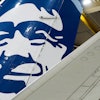
 As the aviation industry advances, so does the search for new technologies that streamline and improve the overall engine maintenance process.
As the aviation industry advances, so does the search for new technologies that streamline and improve the overall engine maintenance process.
To aid mechanics and technicians performing engine maintenance, Honeywell is piloting the use of voice control with the Vocollect Voice Maintenance & Inspection (M&I) Solution at its engine facilities.
Vocollect Voice directs technicians through a checklist while capturing voice data. The technician then interacts with a display to review the images or descriptions.
Finally, the spoken information is converted into text and communicated back to the host data system with real-time updates.
By allowing workers with a mobile method of giving instructions and data collection for induction engines, the solution streamlines engine product line repair and overhaul process.
“The solution provides a hands-free, eyes-free way for mechanics to inspect the asset and document information while they’re inspecting,” explains Prakash Somasundaram, Vocollect New Markets Head of Strategy. “We’re entering this new market by focusing on inspection within the aviation segment, truck and fleet segment, and the automotive segment.”
Today, most technicians are still required to document their findings on a paper-based checklist separate from the inspection and maintenance process. “[Mechanics] usually spend four to five hours examining an asset, and they end up spending [90 minutes] transferring the information to a PC,” says Somasundaram. “The fact that Voice is doing this while they’re performing the inspection saves them a lot of time.”
Although Honeywell has already been using the Voice technology in healthcare facilities and warehouses for about five years, the company first started working within the aviation industry about two years ago.
“We initially started using the Voice M&I Solution at Honeywell’s auxiliary power unit (APU) maintenance, repair, and overhaul Sky Harbor Facility in Phoenix,” says Somasundaram. “That was our pilot site, but we’ve since expanded to other sites.”
Streamlining Documentation
The Voice Solution consists of the Talkman A730 wearable device and SRX2 wireless headset, along with a combination of software applications. The technology can integrate with information from the user’s host data system, such as the ERP or Enterprise Asset Management (EAM) software.
 The small, 9.7 oz (with standard battery) Talkman A730 integrates voice and a short-range scanner in one wearable device. A worker can even scan hands-free by speaking a voice command to activate the scanner on the worker’s belt. The apparatus is also equipped with a visible pointer to facilitate scans in darkness or full sunlight.
The small, 9.7 oz (with standard battery) Talkman A730 integrates voice and a short-range scanner in one wearable device. A worker can even scan hands-free by speaking a voice command to activate the scanner on the worker’s belt. The apparatus is also equipped with a visible pointer to facilitate scans in darkness or full sunlight.
“Like most product development practices, we went through a very controlled process from identifying a market to launching a product,” says Somasundaram. “After we understood the stakeholders, competitors, and market trends, we were able to go through multiple design cycles.”
The wearable device integrates the Intermec EA30 imager, which provides a 2D imager that is 50 times more motion tolerant than standard 2D imagers. In fact, it doesn’t even require bar code alignment to read. While in development, the device was proven to withstand an operating temperature from -8° to 122°F, and can survive 24 drops at 1.5 meters onto steel and 12 drops at 1.8 meters onto steel.
The wearable device’s companion SRX2 wireless headset provides an embedded multi-microphone array to reduce unwanted word and sound. A padded headband provides 280° spin for multiple levels of user adjustment, and the 6.84 oz (with battery) headset’s compact batteries last two full shifts in dry facilities, and up to 10 hours in freezer environments.
Developing An Accurate Product
Although Honeywell recently acquired the company in September 2013, Vocollect has specialized in industrial voice recognition for more than 45 years. “We build our voice application solution very specific for workflow, meaning that at any given step or point in time, there are limited options that the user can say,” explains Somasundaram. “It automatically cuts down the options that the system can pick up.”
The solution also has the added benefit of time stamping every step of the mechanic’s review process. Previously, supervisors were provided with little insight into how much time it took the mechanics to inspect the asset, because it depended upon if they remembered to write down their start and stop times.
“Today, most mechanics are documenting findings in their own style,” says Somasundaram. “To have all mechanics across all locations recording information in the exact same style would be a huge benefit to the quality and consistency of service.”
To further ensure accuracy, specialists visit the customer’s maintenance site to assist with training the user to adapt the templates to his or her voice. It is essential to know what types of environmental noises surround the application. Somasundaram explains, “Whether we’re going to a warehouse or a maintenance facility, we’ve got to map all the background noises.”
According to Somasundaram, the training and features ensure an accuracy of 99.99 percent. Users talk in a natural way, and the technology is available in more than 35 languages. More than a million workers currently use the technology on a daily basis.
“We take any checklist from the customer’s site and convert that into a voice checklist,” explains Somasundaram. “We also have some standard inspection plan checklist templates that the customers can start with.” In addition, a graphical user interface tool is provided for the supervisor to manage the voice checklists when desired.
Beyond Voice Interactions
Honeywell had to build an entirely new suite of software for its Voice M&I Solution, including the application that’s running on the device; the application that connects back to the host system; and updates to the firmware and device management software. “The whole process, from identifying the user’s needs and developing a new software suite, took about a year,” says Somasundaram.
Honeywell’s goal was to make its Voice M&I Solution interface as natural as possible. The focus is not to have more interaction with the device, but to have more focus on the job being performed. “Our aim is to get the product out of the way, meaning the less the technician or mechanic is interacting with this technology, the better it is,” says Somasundaram.
This article originally appeared in the July/August print edition of PD&D.






















